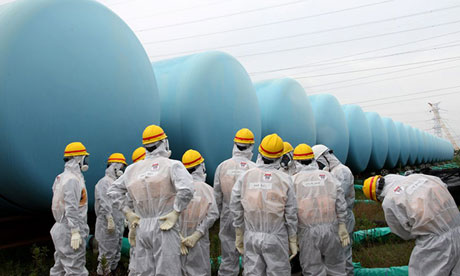Fukushima radiation leaks reach deadly new high
Exposure to emissions would be fatal within hours, say Japanese authorities, as race to build frozen wall begins

Staff of Japan's nuclear regulator near storage tanks for radioactive water at the Fukushima Daiichi power plant. Photograph: EPA
The crippled Fukushima Daiichi nuclear power plant has radiation leaks strong enough to deliver a fatal dose within hours, Japanese authorities have revealed, as the government prepares to step in to help contain leaks of highly toxic water at the site.
On Wednesday the country's nuclear regulation authority said radiation readings near water storage tanks at the Fukushima Daiichi nuclear power plant have increased to a new high, with emissions above the ground near one group of tanks were as high as 2,200 millisieverts [mSv] per hour – a rise of 20% from the previous high.
Earlier this week the plant's operator, Tepco, said workers had measured radiation at 1,800 mSv an hour near a storage tank.
That was the previous highest reading since Tepco began installing tanks to store huge quantities of contaminated water that have built up at the plant.
An unprotected person standing close to the contaminated areas would, within hours, receive a deadly radiation dose. The nuclear regulation authority said the radiation comprised mostly beta rays that could be blocked by aluminium foil, unlike more penetrative gamma rays.
Tepco's admission in August that about 300 tonnes of radioactive groundwater is escaping into the nearby Pacific Ocean every day, and the more recent discovery of leaking storage tanks and pipes, prompted the government to inject more than £300m to contain the water crisis.
The emergency measures, announced on Tuesday, involve building a mile-long impenetrable frozen wall beneath the plant to prevent groundwater from mixing with contaminated coolant water. The coolant becomes tainted after coming into contact with melted uranium fuel deep inside the damaged reactors.
Currently about 400 tonnes of groundwater are streaming into the reactor basements from the hills behind the plant each day. The water is pumped out and held in about 1,000 storage tanks. The tanks contain 330,000 tonnes of water with varying levels of toxicity.
Officials are conducting a feasibility study into the frozen wall, with completion expected by March 2015. Although the technology isn't new, the scale of the Fukushima Daiichi project is unprecedented for an atomic facility.
The government also wants to speed up the development of a new water treatment system that can remove most radioactive substances from the water. Tepco has already constructed once such facility but it has not been used since equipment was found to have corroded during a trial run.
The prime minister, Shinzo Abe, said he understood the growing concern at home and overseas about the state of the plant but said his government was now "taking the lead" to solve the problem. "To do that we are resolutely implementing drastic measures."
Abe, who will make Tokyo's final pitch in the city's bid to host the 2020 Olympics at a meeting of the International Olympic Committee in Buenos Aries this weekend, added: "I will be explaining to the IOC that in seven years' time, 2020, it will not be a problem at all."
http://www.theguardian.com/environment/2013/sep/04/fukushima-radiation-deadly-new-high
No comments:
Post a Comment